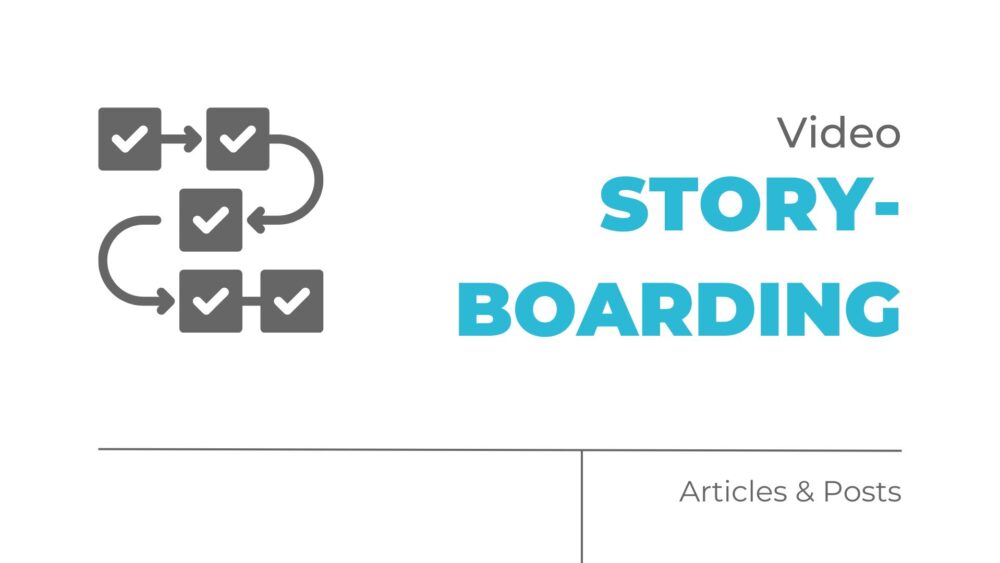Did you know that a well-crafted storyboard can make your video production process smoother and more efficient?
Storyboarding is a super important step in planning and visualizing your video.
Video storyboarding is the process of creating a visual blueprint for your video project.
It’s about making sure every scene is meticulously thought out before you start filming.
Storyboarding helps you be more effective and make the most of your time.
In this article, we’ll dive into what video storyboarding is, its purpose, and the different types of storyboards you can use.
What is Video Storyboarding?
A storyboard typically consists of a series of panels, much like a comic strip, where each panel represents a shot or a scene in your video.
These panels are accompanied by notes or descriptions that provide additional details about the action, dialogue, and other elements.
It literally involves sketching out each scene in a sequence, including details like camera angles, dialogue, and key actions.
This allows you to plan the flow of your video and see to it that everyone involved in the production understands the vision.
What is the Point of a Storyboard?
The main purpose of a storyboard is to visualize your video before production begins.
It helps in several key areas:
- Organization: Storyboarding allows you to organize your ideas and structure your video logically. This prevents confusion during the production process and helps you produce a clear, cohesive final product.
- Communication: A storyboard serves as a communication tool between the director, camera operators, actors, and other crew members. This is how we get everyone on the same page with the creative vision.
- Efficiency: By planning each shot in advance, you can avoid unnecessary reshoots and make the filming process more efficient. This saves time and resources, making the production smoother and more cost-effective.
- Creative Visualization: Storyboarding allows you to experiment with different ideas and visualize how they will work on screen. You can identify potential issues and make adjustments before filming begins.
What is the Difference Between a Storyline and a Storyboard?
A storyline is the narrative or plot of your video.
It outlines the sequence of events and how the story will unfold from beginning to end.
The storyline includes the main characters, key events, conflicts, and resolutions.
A storyboard, on the other hand, is a visual representation of the storyline.
It breaks down the narrative into individual scenes and shots, showing how each part of the story will be captured on camera.
While the storyline provides the framework of the story, the storyboard translates that framework into specific visual elements.
In essence, the storyline is the “what” of your video, while the storyboard is the “how.”
The storyboard takes the abstract elements of the storyline and turns them into concrete visual plans that guide the production process.
What are the Three Types of Storyboards?
There are several types of storyboards, each serving a different purpose in the video production process:
Traditional Storyboards
Traditional storyboards are hand-drawn or digitally created sketches that outline each scene.
These are the most common type of storyboards and are used to plan the visual and narrative flow of the video.
They can be simple black-and-white sketches or detailed color illustrations, depending on the project’s needs.
Thumbnail Storyboards
Thumbnail storyboards are smaller, less detailed sketches that provide a rough overview of the video.
They are often used in the early stages of planning to quickly explore different ideas and visual sequences.
Thumbnails focus on the general composition and movement rather than detailed visuals.
Animatic Storyboards
Animatic storyboards, or animatics, are animated versions of storyboards.
They combine the storyboard panels with sound, dialogue, and timing to create a rough draft of the video.
Animatics help visualize how the final video will look and feel, allowing for adjustments in pacing and flow before full production.
At the End of the Day
Storyboarding is an essential step in video production that helps organize, visualize, and communicate your creative vision.
By understanding what a storyboard is, its purpose, and the different types available, you can create more effective and engaging videos.
Remember, a well-planned storyboard can save time, resources, and help you achieve a polished final product.
If you need help creating a professional storyboard, consider working with a video design company to bring your vision to life.


Comments are closed.